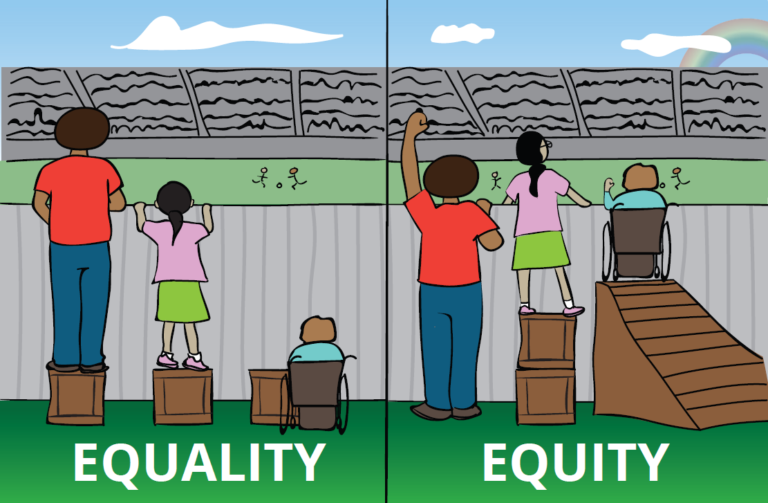Equitable Assessment
Assessment May Not Always be Equal, But it Can be Equitable
Equal means that strategies, processes, and resources are evenhanded and equivalent. In schools and classrooms, it is easy to endorse equality as an ideal, but it may not be the norm. All learners may not have consistent access to information and resources. Some families and communities have less access to health care or affordable housing and healthy foods. These gaps leave students more vulnerable in numerous ways. http://thefoodtrust.org/uploads/media_items/grocerygap.original.pdf
Equitable, as a reflection of fairness, is also more challenging in lower-income communities. Equity means that an action, amount, or extent is appropriate for the people, situation, conditions, and context. For example, in a race around the world contest, if one group has access to jet planes and another to rowboats, it could be viewed as unfair or inequitable. For learners, educational and assessment equity means endeavoring to achieve the best possible outcomes for each learner.
If you were asked to decide which is better, equality in assessment or equity in assessment, equity would be the better choice. Throughout the school year, students routinely take the same or equal measures of their learning. (For example, standardized tests or quizzes derived from teacher’s guides.) The greater challenge is providing assessments that are equitable and fair for all learners.
Reframing assessment through a lens of fairness and equity means that every student has multiple and/or varied opportunities to show what they know, understand, and can do in response to visible learning intentions and well-defined and anticipated outcomes of learning.
Assessing learning with purpose and fairness: While it is not always feasible to give each student an individualized assessment, it is possible to minimize uniformity and increase flexibility in the routines and strategies of assessment. In doing so, students learn that there are numerous ways to show what they know and can do. And also that mistakes can be opportunities for learning by self-correcting their missteps, explaining their misunderstandings, and asking for further clarification.
ACTIONS AND PATHWAYS FOR INCREASING EQUITY IN ASSESSMENT
1. Assure that students know and understand the intentions, processes, and outcomes of learning. Ask them to restate these in their own words. Routinely rely on formative assessments to check for understanding.
2. Gauge learning over time: Whether it be a pretest, homework, or summative assessment, be sure students recognize how the learning outcomes align with the learning intentions. When assessment is sequenced through levels of the taxonomy from understanding to analysis, a learner’s misunderstandings become more evident, and in turn, responses can be more purposeful.
3. In place of numerical scores or letter grades, use varied point values for assignments and assessments. For example, weigh demonstrations and evaluations of learning with more import than selected-choice quizzes. A learner’s accurate analysis of problems accompanied by comprehensive and well-defined solutions is worthy of more credit than short-answer questions.
4. Provide alternative pathways for students to show what they have learned as well as opportunities to select how to display their level of mastery. Whether they are explaining a math solution to an extra-terrestrial or critiquing the actions or decisions of a character in a story, ensure that they understand their options as well as scoring criteria.
5. When a more traditional assessment is returned, students can self-correct their slip-ups with explanations such as “I used to think…, but now I know.”. If desired or relevant, include a “because___” so they can explain their change in understanding or skill level.

IDEAS and PRACTICES TO CONSIDER
Check the balance of your grading methodologies. What is essential in your setting, for your students, grade level, and content area? Consider ways to reduce reliance on test scores while increasing the importance of students explaining their learning and showing their self-corrections when an assessment is returned.
Consider ways to make your scoring and grading more transparent. For example, on an assessment, include point values for different sections, perhaps based on the depth of skills and knowledge required or the complexity of the assessment task (i.e., show your steps vs. a concise summation).
Sequence an assessment through levels of the taxonomy. Sometimes a prompt from a recall question will guide a student in responding to an application or comparison question.
As feasible, incorporate multiple ways, formats, and paths for students to show their learning. Sean may want to write a paragraph explaining a concept, while Akila may diagram her ideas.
Offer students opportunities to reflect on their learning process, the assessment, and their score.
1. I did/did not like this lesson or topic because:
2. I did/did not like the process and sequence for learning because:
3. It was easy for me to learn this because:
4. It was hard for me to learn this because:
5. Here are two to three useful things I have learned (these could be facts, processes, or self-awareness):
6. One (or more) way(s) I can use or apply my learning now or in the future:
7. One to two ideas, strategies, or areas that continue to confuse me:
REFERENCES and FURTHER READING
Image: Appreciation to: https://www.equitytool.org/equity/
Gibbs, Caroline. What do We Mean by Equity in Relation to Assessment https://www.tandfonline.com/doi/abs/10.1080/0969595950020303?journalCode=caie20
“Prologue to Mallory’s Dilemma” excerpted fromGrading for Equity: What It Is, Why It Matters, and How It Can Transform Schools and Classrooms Feldman, Joe, Thousand Oaks, CA: Corwin, 2019.
Spaull, Kynan, 2012 Equitable Assessment: How to make School-based Assessment more Equitable. https://prezi.com/3z8ik7ns–b8/equitable-assessment/
Suskie Linda, AAHE Bulletin, May 2000 Fair Assessment Practices: Giving Students Equitable Opportunities to Demonstrate Learning. http://citeseerx.ist.psu.edu/viewdoc/summary?doi=10.1.1.540.9919
SUBMITTED BY
Laura Greenstein, Ed.D.
Assessment Network https/www.assessmentnetwork.net
laura.m.greenstein@gmail.com
